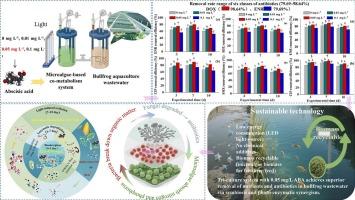不同微藻基系统处理牛蛙养殖废水脱落酸浓度对营养物及抗生素去除性能的影响
IF 4.5
2区 生物学
Q1 BIOTECHNOLOGY & APPLIED MICROBIOLOGY
Algal Research-Biomass Biofuels and Bioproducts
Pub Date : 2025-09-22
DOI:10.1016/j.algal.2025.104310
引用次数: 0
摘要
本研究系统评价了添加脱落酸(ABA)的不同微藻系统处理牛蛙养殖废水的性能,重点研究了营养物(COD、TN、TP)和抗生素的去除。建立了4个试验装置:普通小球藻单培养(处理1)、普通小球藻与球形红假单胞菌(处理2)或辣木曲霉J-26(处理3)共培养,以及三种微生物混合培养(处理4),分别用浓度为0、0.01、0.05和0.1 mg L−1的ABA处理。结果表明,添加0.05 mg L−1 ABA的处理4系统具有较好的效果,在10 d的处理周期内,化学需氧量(COD)去除率为90.51%,总氮(TN)去除率为88.72%,总磷(TP)去除率为92.51%。对恩诺沙星(ENR)、环丙沙星(CIP)、磺胺嘧啶(SDZ)、磺胺甲恶唑(SMX)、氟苯尼醇(FFC)和盐酸多西环素(DOX)等6种靶标抗生素,去除率从79.69% (ENR)到98.64% (DOX)不等,其中DOX等光敏抗生素的降解率最高。本研究为aba调控的微藻-细菌-真菌系统的协同效应提供了实证证据,为解决牛蛙养殖废水中复杂的污染挑战提供了可持续和高效的策略,促进了水产养殖业生态友好型废水处理技术的发展。本文章由计算机程序翻译,如有差异,请以英文原文为准。

Effect of abscisic acid concentration on nutrient and antibiotics removal performance by different microalgae-based system treating bullfrog aquaculture wastewater
This study systematically evaluated the performance of diverse microalgae-based systems supplemented with abscisic acid (ABA) in treating bullfrog aquaculture wastewater, focusing on nutrient (COD, TN, TP) and antibiotic removal. Four experimental setups were established: single culture of Chlorella vulgaris (Treatment 1), co-cultures of Chlorella vulgaris with Rhodopseudomonas sphaeroides (Treatment 2) or Curvularia moringae J-26 (Treatment 3), and a tri-culture system combining all three microorganisms (Treatment 4), each treated with ABA concentrations of 0, 0.01, 0.05, and 0.1 mg L−1. Results revealed that the Treatment 4 system with 0.05 mg L−1 ABA demonstrated superior efficiency, achieving removal rates of 90.51 % for chemical oxygen demand (COD), 88.72 % for total nitrogen (TN), and 92.51 % for total phosphorus (TP) over a 10-day treatment period. For six target antibiotics—including enrofloxacin (ENR), ciprofloxacin (CIP), sulfadiazine (SDZ), sulfamethoxazole (SMX), florfenicol (FFC), and doxycycline hydrochloride (DOX)—removal efficiencies ranged from 79.69 % (ENR) to 98.64 % (DOX), with photosensitive antibiotics like DOX showing the highest degradation. This study provides empirical evidence for the synergistic efficacy of ABA-regulated microalgae-bacteria-fungi systems, offering a sustainable and efficient strategy to address the complex pollution challenges in bullfrog aquaculture wastewater and facilitating the development of eco-friendly wastewater treatment technologies for the aquaculture industry.
求助全文
通过发布文献求助,成功后即可免费获取论文全文。
去求助
来源期刊

Algal Research-Biomass Biofuels and Bioproducts
BIOTECHNOLOGY & APPLIED MICROBIOLOGY-
CiteScore
9.40
自引率
7.80%
发文量
332
期刊介绍:
Algal Research is an international phycology journal covering all areas of emerging technologies in algae biology, biomass production, cultivation, harvesting, extraction, bioproducts, biorefinery, engineering, and econometrics. Algae is defined to include cyanobacteria, microalgae, and protists and symbionts of interest in biotechnology. The journal publishes original research and reviews for the following scope: algal biology, including but not exclusive to: phylogeny, biodiversity, molecular traits, metabolic regulation, and genetic engineering, algal cultivation, e.g. phototrophic systems, heterotrophic systems, and mixotrophic systems, algal harvesting and extraction systems, biotechnology to convert algal biomass and components into biofuels and bioproducts, e.g., nutraceuticals, pharmaceuticals, animal feed, plastics, etc. algal products and their economic assessment
 求助内容:
求助内容: 应助结果提醒方式:
应助结果提醒方式:


